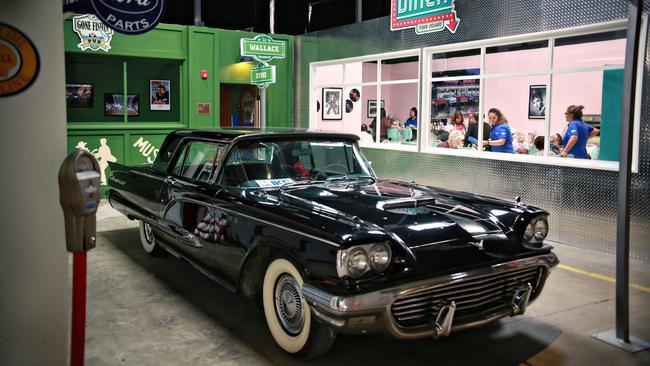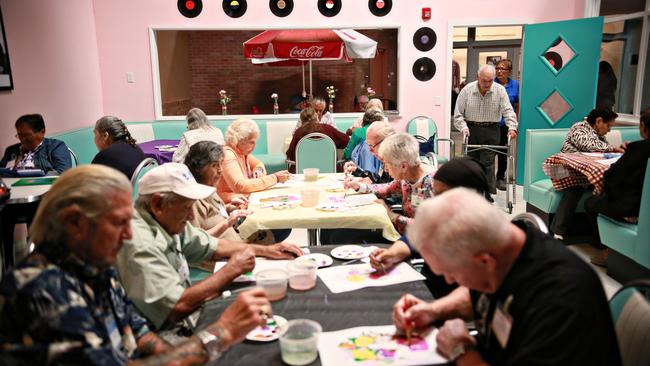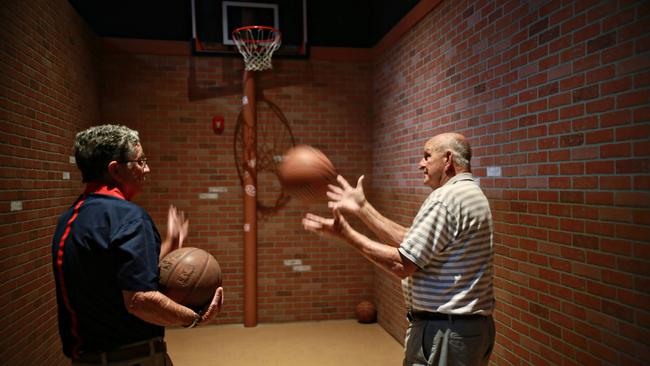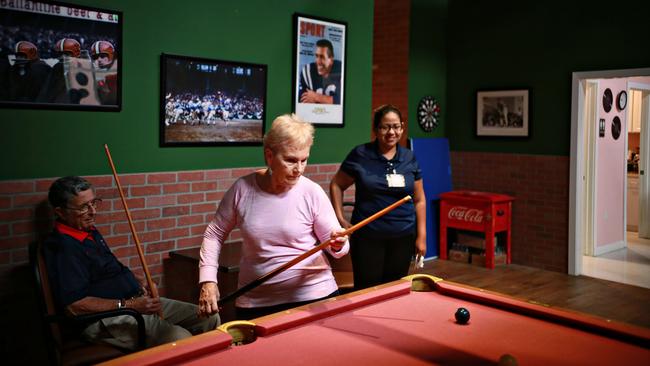Reminiscence therapy aims for sweeter memories
Amid horror stories about the treatment of older Australians, the US has opened its first memory-care facility to take dementia patients back to the prime of life.

The two men, high school buddies, sit in a turquoise and white booth at Rosie’s Diner, ribbing each other like they are teenagers at Sweetwater High School, where they played baseball together so many years ago.
A 1950s-era jukebox spits out tunes such as Peggy Sue by Buddy Holly. Vinyl records and black-and-white pictures of celebrities such as Elvis Presley and Audrey Hepburn line the walls.
Now in their 70s, James Mann and Richard Eshbach are actually in Glenner Town Square, a new adult daycare centre for dementia patients that is like entering a time warp. The 11 shopfronts that surround an indoor park represent the time period from 1953 to 1961, when most of the patients were in the prime of their life.
Glenner Square opened last month and is believed to be the US’s first memory-care facility built entirely around the idea of reminiscence therapy, a therapy that uses prompts from a person’s past — such as music, movies and photographs — to elicit memories and encourage conversation and engagement. It’s a behavioural approach to treating Alzheimer’s and dementia patients, often used in nursing homes in The Netherlands and other countries, that is growing in popularity as efforts to create effective drugs for the memory-robbing disease fail.
“We know dementia makes it hard for patients to remember the recent past, like the last 10 years, whereas the older memories are preserved better for a longer time, especially memories from childhood and early adulthood,” says Dorthe Berntsen, a psychology professor and head of the Centre on Autobiographical Memory Research at Aarhus University in Denmark.
Her studies have found that dementia patients can engage more when they are exposed to objects from the past.

“You want to have an environment that fits the kind of memories that people have,” she says. “It doesn’t cure dementia, of course, but it does provide a context where these people have a better connection to their past and to their sense of identity.”
Research on reminiscence therapy is mixed. Berntsen’s most recent study tested a five-week Danish program in which about half of 43 Alzheimer’s patients were assigned to weekly sessions in an authentic, 1950s-style apartment in a local museum, while the other half got standard care.
Most participants showed no improvements in a series of cognitive tests done before and after the intervention. But they did become better at talking about autobiographical memories when triggered from older objects.
A recent review by Cochrane — a non-profit that organises medical research findings for health professionals, policymakers and patients — concluded that the effects of reminiscence therapy were inconsistent and small in size. Still, it says that there is some evidence it can improve quality of life, cognition, communication and mood.
MORE: Trying reminiscence therapy at home
Myrra Vernooij-Dassen, a professor at Radboud University Medical Centre in Nijmegen in The Netherlands who also chairs a European network of dementia researchers, says the Cochrane conclusions were “promising”.
“It’s very hard to do research in this kind of group and to get positive effects,” Vernooij-Dassen says. “People with dementia still are people with their capacities, with their dignity. We can use these capacities, and reminiscence is one of the ways that we can stimulate people with dementia. If they have the right treatment then they can stay stable for really many years.”
Glenner Town Square is a partnership between the George G. Glenner Alzheimer’s Family Centres — a California-based non-profit organisation — and Senior Helpers, a national in-home senior care provider.
The partners have plans to franchise the concept and open up similar centres across the US. Peter Ross, chief executive and co-founder of Senior Helpers, says they’ve already received interest in the concept and hope to have 200 Town Squares across the country in the next five years.

Glenner is 836sq m with 7.3m ceilings. It’s licensed for 75 patients a day and has more than 50 patients enrolled, though the number of patients who attend the centre on a given day fluctuates as patients can create their own schedule depending on their families’ needs. It is open for a half day or a full day every weekday.
The program is mostly geared towards patients who are in the early to moderate stages of dementia, who typically are living with family or at home with caregivers. Their family members or caretakers drop them off at the facility.
“We really looked to bring people back to where their fondest memories are, typically between the ages of 10 and 30,” says Scott Tarde, chief executive and executive director of Glenner Centres, noting that the average participant is about 82. The facility hasn’t been open long enough to assess the benefits of the program but it is participating in research on its effectiveness.
The setting — an idealised vision of the 50s that omits explicit references to societal injustices that civil rights and later feminist movements battled against — may not resonate for all patients, who include immigrants from China, The Philippines and Latin America, as well as African-Americans. The son of one Chinese immigrant, for instance, says his mother probably doesn’t relate much to the memorabilia and items.
Tarde says the centre tries to incorporate activities that relate to other cultures, such as playing games such as Loteria, a Mexican game similar to bingo. He says staff are “sensitive and aware of history and absolutely will recognise history, civil rights and cultural days, weeks and months” with activities that acknowledge the diversity of patients.
Reminiscence therapy is not expected to restore patients’ capabilities fully — there is still no cure for Alzheimer’s — but participants may show glimpses of their former selves, says Mindy Baker, director of education at Glenner Centres. Participants are placed in groups as they rotate through shopfronts led by staff in different activities. Patients who require more assistance pay $US65 ($90) for a half day or $US95 for full daycare. Those in the earlier stages of dementia who don’t require medications pay $US60 or $US85.
The centre of the village is a small, indoor park, with natural skylights, and artificial grass for a small putting green and bocce court. Parakeets from the adjacent pet store add to the ambience.
Tarde points to a real 50s San Diego police call box, a pay phone that calls the front desk and a restored 1959 black Ford Thunderbird car, which patients can get in and even open the hood to tinker with it.

A clinic where the centre’s registered nurse works has cribs with lifelike baby dolls that patients cradle. There is a library with a card catalogue, a 50s National Geographic set and Monopoly and Scrabble games circa 1930. A re-created home space called the Little Blue House has an original Philco fridge and a record player.
At the cinema, The Greatest Show on Earth plays in 15-minute clips. At Joy’s department store, patients can shop and even bring home a fur coat and bowling shoes. And at the Gone Fishin’ Pub there’s a pool table, a mini-basketball court and darts. The shopfronts use graphics and pictures that can be changed to re-create different eras for different generations of patients.
Staff work in a City Hall office space. Among them: Susie Heavilin, 69, a former accountant who was diagnosed with Alzheimer’s last year and believes she’s their bookkeeper.
“They print out invoices for her,” says Sheri Berg, her daughter. “It’s really given her a sense of purpose. It’s really changed everything for us.”
Activities buzz in different corners. A painting class is conducted in the diner while in the library Marilyn McPhie, a storyteller, talks about trains and railroads. She passes around a penny flattened by a train.
Mike Casey, 78, a retired orthopaedic surgeon who was diagnosed with Parkinson’s disease and dementia two years ago, cradled it affectionately.
Later, Casey, who was at Town Square for the first time, called the session “remarkable”. (He is one of the few Glenner patients who is sufficiently aware of his condition to be able to reflect on the treatment.) He recalls living two blocks from a train station in St Louis, where he grew up.
“I can remember vividly sneaking down there and putting my ear on the rail and you hear a train coming, look down and see a train that’s a mile down but looks like it’s eight feet away,” says Casey.
At a music and theatre class later in the day, Trevor Gibson, a local piano player, leads the multilingual group in songs ranging from La Bamba to Cielito Lindo. Two women get up and spontaneously start ballroom dancing together.
Meanwhile, at the local pub an employee leads a group of patients in a game of penny poker. And in the Little Blue House a woman, alone, watches an iPad with black-and-white episodes of I Love Lucy.
Mann and Eshbach hadn’t been in touch for decades until they bumped into each other at a local Alzheimer’s disease support group a couple of years ago, says Mann’s wife, Marsha Mann.
Her husband is diagnosed with mild cognitive impairment, a type of memory loss. Eshbach was diagnosed with Alzheimer’s in 2016. The two now go to Town Square together once a week.
Mann’s wife says she noticed an “elevated cognition” in her husband after he went to Town Square. He belted out a Leonard Cohen song. “I just felt like he was more conversant,” she says. “The singing, it just warmed my heart.”
The Wall Street Journal

